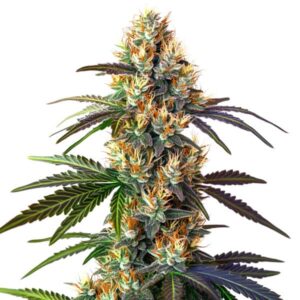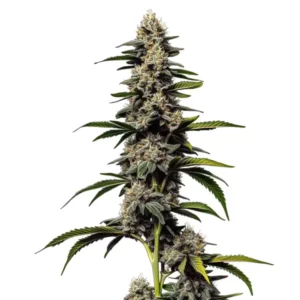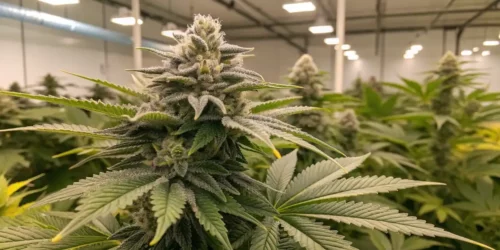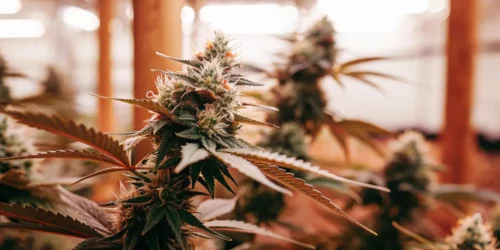Marijuana plants require specific amounts of nutrients in each phase to grow successfully. One of these nutrients is phosphorus, which is necessary in various processes of your plants. Today, we will discuss phosphorus deficiencies and excesses, how to detect them, and how to combat them.
Phosphorus (P) is a vital nutrient for marijuana plants, playing a significant role in their germination, root growth, plant growth, flowering, and cloning. As it is such a crucial element in the plants’ development, it is important to be able to distinguish when they are experiencing phosphorus excesses or deficiencies.
Why is phosphorus important in cannabis growing?
Cannabis plants, whether feminized, autoflowering, or regular, accumulate a significant amount of the energy they receive from the sun in the form of phosphorus, which is later used to carry out various metabolic processes necessary for the plants.
The plant’s absorption of phosphorus also varies depending on the substrate’s pH level. The higher the substrate’s pH level, the lower the plant’s phosphorus absorption, which can lead to deficiencies.

A good level of phosphorus will provide:
- Greater root development.
- More vigorous and robust growth.
- Enhanced water utilization in the substrate.
- Increased resistance to cooler temperatures.
- Higher production of sugars and starches, resulting in better quality buds.
Promos & Deals
What is Cannabis Phosphorus Deficiency?
When plants do not properly assimilate phosphorus, it will manifest as a deficiency in the areas with the highest plant activity, such as the stems and newer leaves. Additionally, the plant will be more vulnerable to insect pests, fungi, and diseases.
If the phosphorus deficiency continues to worsen, the plant may exhibit the following symptoms:
- Delay in the growth of new shoots and leaves.
- Necrosis at the tips of the leaves, taking on a dark green almost bluish color, eventually drying up and wrinkling before falling off the plant.
- Stems and petioles take on a purple hue.
- Buds do not reach their optimal size and quality.
Phosphorus and Its Importance in Plant Growth
Phosphorus is used by plants to help form new roots, produce seeds, and buds. It is also used by plants to combat diseases. Right after germination, cannabis can draw nutrients from the seed itself. Similarly, most commercial soil mixes already contain sufficient phosphorus.
It won’t be necessary to apply additional fertilizers until the third week of the growth cycle when the plant has reached a height of approximately 15cm. Otherwise, providing more nutrients too early can negatively affect root development and the overall health of the seedling.
The Nutrient Needs of Cannabis Plants
What causes phosphorus deficiency in cannabis plants?
One factor contributing to phosphorus deficiency is root pH. A pH in the range of 6.2 to 7 in the roots is optimal for maximizing nutrient absorption. Therefore, the goal is to adjust the soil’s pH to fall within that range when deficiency symptoms appear. This can be achieved by using pH-modifying products.
Overwatering your plants and compacted soil can also lead to phosphorus deficiency. Ensure proper watering practices to avoid this issue. Stay patient if you notice the early signs of phosphorus deficiency. If you rush and add too much phosphorus to the soil, it may hinder the plants’ ability to absorb other nutrients, causing even more damage.
Temperature is another critical factor to consider for achieving optimal phosphorus levels. Colder temperatures can impede the uptake of adequate nutrient levels in your cannabis crop. Temperatures below 15°C/59°F can begin to have adverse effects.
If your plants exhibit symptoms of phosphorus deficiency, you can expect to see a recovery by taking the right steps to restore your plants’ health. Brown spots, red and purple stems, and other symptoms will no longer affect new leaves. Don’t worry if old leaves do not recover; this is normal.
Identifying Phosphorus Deficiency
Phosphorus deficiency in marijuana plants can be identified in the larger, older leaves at the bottom of the plant. Symptoms manifest in the leaves, which turn dark green or yellow and often display brown or bluish spots. Over time, as phosphorus deficiency progresses, the leaves will become thick and rigid, crispy and dry, with shiny dark patches.
Depending on the strain, phosphorus deficiency can also cause the stem to turn reddish or purplish.
Visual Symptoms of Phosphorus Deficiency
Fortunately, there are some symptoms that can assist you in recognizing a phosphorus deficiency. As with most plant issues, the first thing to observe is the fan leaves. Leaves lacking in P turn bluish-green, unlike the bright green of a healthy plant.
Additionally, dark coppery spots near the tips of the leaves appear, although this typically occurs in more advanced cases. The petioles take on a purple hue, signaling that something is amiss.
Finally, the plant’s vertical growth becomes stunted, significantly impacting its productivity and overall health.
How to Differentiate Phosphorus Deficiency from Other Issues
Differentiating phosphorus deficiency from other plant problems can be challenging, but there are several key signs and methods you can use to identify phosphorus deficiency specifically. Here’s how to differentiate phosphorus deficiency from other problems:
You can carry out a visual inspection of the plants and the specific affected areas.
It analyzes the PH levels of the substrate and also analyzes the composition of the substrate and its nutrients.
Review the nutrients, the content of each of them and their compositions. Analyze the PH of the nutrients and the water in which you dissolve the nutrients if they are liquid. Yes, the nutrients are solid, also check the manufacturer’s description regarding their PH.
The Importance of Regular Plant Inspections
Checking the plants daily is essential to have healthy specimens in the garden and prevent them from suffering from diseases. For this reason, we recommend that you have a notebook where you make notes on the progress of the plants and also on factors such as humidity and temperature in the growing area.
Obviously, you must record the irrigation and the amount of water in your notebook to make an adequate segmentation of the irrigation. Nutrients are essential, so measuring the pH is a very good thing and having a record of the quantities applied to each plant is a very necessary issue.
Soil and Phosphorus Deficiency

For various reasons, phosphorus deficiency may occur in the substrate in the plant. It is good to review what substrate phenomena cause phosphorus deficiency, so before starting to grow, choose the best possible substrate.
Remember not to reuse substrate because it can cause a substrate deficiency. And if you enhance the substrate yourself at home, try to do it following the step-by-step guide so as not to have problems as the crop progresses.
Soil pH and Its Impact on Phosphorus Availability
One of the main causes of phosphorus deficiency is soil pH. In alkaline soils, with a pH greater than 7, the solubility of phosphorus decreases because it reacts with calcium (Ca), forming insoluble or low-solubility compounds like calcium phosphates.
On the other hand, in soils with a pH lower than 6, phosphorus tends to be fixed by aluminum (Al) and iron (Fe), precipitating as insoluble compounds. In this regard, the soil pH range where the maximum phosphorus availability occurs is from 6 to 7.
Other possible causes of phosphorus deficiency in crops include soil compaction, low temperatures, excess or lack of moisture, limited root growth, the impact of pests and diseases on roots, and low organic matter content in the soil.
Tips for Improving Phosphorus Uptake in Soil
Keep the pH in the soil you grow in the range of 6 to 7. Avoid using very hard substrates or those that compact easily, and instead, use substrates with a balanced amount of coconut fiber. Coconut fiber allows the substrate to be more aerated, therefore, this helps plants to better acquire nutrients.
Keep your plants healthy, free of pests, insects and diseases that can damage them and weaken their vigor, leading to a phosphorus deficiency.
Organic vs Synthetic Phosphorus Sources
Both organic fertilizers and mineral fertilizers provide nutrients such as phosphorus to plants. Before applying a nutrient, it is important to analyze the composition of the fertilizer or stimulant that is on the labels of each product.
By looking at the labels you will be able to see how much phosphorus the product contains and the pH levels that the product has. Before applying it, you can manage these data to regulate the pH if you need it while avoiding phosphorus imbalance.
leaf irrigation for Rapid Phosphorus Uptake
In foliar fertilization, the phrase ‘spray and pray’ highlights the uncertainty surrounding absorption mechanisms. To improve its effectiveness and reduce risks, follow these guidelines:
- Adjust the solution’s pH to 5-6 for better nutrient absorption.
- Use small droplets with a high-pressure sprayer to cover plants evenly.
- Test the solution’s safety by spraying one plant and waiting 24 hours to check for adverse reactions.
- Spray during cooler, high humidity conditions (>70%) to improve absorption.
- Avoid spraying in high temperatures and low humidity.
- Add a wetting agent or soap to reduce surface tension and enhance absorption.
- Choose a fertilizer with chelated nutrients to prevent reactions.
- Extend wet contact for better absorption during the growth stage, but ensure rapid drying during flowering to prevent fungal issues.
- Be cautious of elevated Electrical Conductivity (EC) levels causing leaf burns.
- Use foliar fertilization during growth and early flowering, avoiding it once buds form.
- Avoid excessive foliar fertilization to encourage root development.
- Optimal for controlled environments with thinner leaf cuticles.
- Never spray with lights on to prevent bulb damage and tissue burning.
- Cease spraying at least three weeks before harvesting, and rinse leaves with a final water-only spray.
- Be mindful of scented organic fertilizers affecting the taste and smell of buds near harvest.
Hydroponic vs Soil Strategies
As we know, growing in soil or hydroponics are two options that can be taken when you want to grow weed. However, it should be taken into account that nutrition in soil cultivation and hydroponic cultivation are completely different.

First of all, in soil cultivation, soil is used as a substrate. Soil provides a base rich in nutrients and beneficial microorganisms for plants. Nutrients are obtained naturally from the earth. Growers can amend the soil with organic or chemical fertilizers as needed. Now, it must be taken into account that growing in soil is less precise in terms of nutrient control, since the plant must extract the nutrients available in the soil, which can be more unpredictable. And finally, plants grown in soil are often more resistant to fluctuations in water and nutrient supply due to the soil’s ability to retain water and nutrients.
So, as we have pointed out, follow strategies such as measuring the pH in the substrate and also in the liquids with fertilizers. It is also good to take into account the consistency of the substrates, analyzing that it is well aerated so that the roots can penetrate and absorb the nutrients. Another important detail is that both the nutrient solutions and the substrates must have a correct EC to provide good electroconductivity to the plants that allows them to absorb the necessary nutrients and thus avoid deficiencies.
In hydroponic crops, the growing medium is water, therefore, nutrients are supplied directly to the roots of the plants in the form of a nutrient solution. This allows precise control of the nutrients that plants receive. Additionally, hydroponic systems allow for precise control of pH, EC (electrical conductivity), and nutrients, which can result in faster growth and a better harvest. However, hydroponic growing generally requires more attention and monitoring to ensure conditions are optimal for the plants. Therefore, it is always good to measure the pH and EC of the water in which it is grown. Also, it is necessary to know the components of the nutrients with which you feed the plants in the water, in order to avoid excesses of nutrients or their deficiencies. Don’t forget to measure the pH of the nutrients in the solution with water to maintain the necessary balance.
Phosphorus-Enhancing Microbes and Mycorrhizae
Phosphorus-enhancing microbes and mycorrhizae are beneficial microorganisms that play a crucial role in improving plant growth and nutrient uptake, particularly phosphorus, in various ecosystems. Phosphorus is an essential nutrient for plant growth and often limits plant productivity in many terrestrial ecosystems. These microbes and mycorrhizae help plants access and use phosphorus more efficiently.
Mycorrhizae: Mycorrhizal fungi form mutualistic associations with the roots of most plants. There are several types of mycorrhizae, but arbuscular mycorrhizae (AM) are the most common and relevant for phosphorus uptake. Mycorrhizae enhance phosphorus uptake through several mechanisms:
Increased Absorptive Surface Area: Mycorrhizal fungi extend the root system’s absorptive surface area, effectively increasing the plant’s ability to access nutrients, including phosphorus.
Improved Nutrient Uptake Efficiency: Mycorrhizal fungi can access and absorb phosphorus from soil regions that are typically inaccessible to plant roots. They transfer this phosphorus to the host plant in exchange for carbon compounds.
Enhanced Stress Tolerance: Mycorrhizae can also help plants tolerate environmental stresses, such as drought and disease, which can indirectly improve nutrient uptake, including phosphorus.
The use of phosphorus-enhancing microbes and mycorrhizae in agriculture and land management practices is known as biofertilization. By utilizing these beneficial microorganisms, it is possible to reduce the need for synthetic phosphorus fertilizers, which can be expensive and have negative environmental impacts when they leach into water bodies. Instead, these natural, sustainable approaches can improve nutrient efficiency and enhance plant growth while reducing the environmental footprint of agriculture.
Can phosphorus deficiency be fatal for my cannabis plants?
Phosphorus deficiency can lead to death in marijuana plants. Phosphorus is one of the essential macronutrients for plants, including marijuana. It plays a crucial role in various biological processes, such as photosynthesis, energy transfer, and the synthesis of DNA and RNA molecules.
If a phosphorus deficiency persists, it can significantly weaken the plant, potentially leading to its demise. It is important to monitor and maintain a proper nutrient balance in marijuana plants to ensure healthy growth. This can be achieved through the use of balanced fertilizers designed specifically for cannabis cultivation and by carefully tracking the plant’s nutritional needs.
Are there specific cannabis strains that are less prone to phosphorus deficiency?
There are no specific cannabis varieties inherently less prone to phosphorus deficiency. A cannabis plant’s ability to absorb nutrients, including phosphorus, depends on various factors such as the substrate it’s grown in, environmental conditions, plant genetics, and nutrient management by the cultivator.
Keep in mind that an excess of phosphorus can also be detrimental to cannabis plants, so it’s important to maintain a proper nutrient balance. Plant genetics can influence their ability to handle nutrients, but ultimately, proper management of environmental and nutrient factors is essential to prevent deficiencies and promote healthy growth.
Can I mix phosphorus supplements with other nutrients?
To sum up, while it’s possible to combine phosphorus supplements with other nutrients for cannabis, it’s important to carefully assess your plants’ nutrient needs and follow the recommended guidelines and feeding schedules. Careful monitoring of your plants and adjustments to your nutrient mix will help you achieve the best results in cannabis cultivation.
In order to make a mixture of this type, we remind you to check the amounts of phosphorus that the nutrients you are using have in order to avoid excess phosphorus that ends up damaging the plants.
How often should I inspect my cannabis plants for nutrient deficiencies?
If you carry out a daily examination of your cannabis plants and also make notes of their progress, you will surely be able to quickly notice how the plant you have is evolving. Therefore, we recommend that you be constant and disciplined in cultivation to achieve success and this will allow you to know if your plant suffers from phosphorus deficiency or another disease quickly and accurately.
FAQs
What are the first signs of phosphorus deficiency in cannabis plants?
The earliest signs of phosphorus deficiency in cannabis include dark green or bluish fan leaves, purple or red stems, and slowed vertical growth. As the deficiency progresses, leaves may develop coppery or dark patches, become crispy and dry, and eventually fall off. Monitoring these symptoms early can help prevent long-term damage.
How does soil pH affect phosphorus availability in cannabis plants?
Soil pH directly impacts phosphorus absorption in cannabis. In alkaline soils (pH above 7), phosphorus binds with calcium and becomes insoluble. In acidic soils (pH below 6), it binds with aluminum and iron, reducing availability. Maintaining an optimal soil pH range between 6.0 and 7.0 ensures maximum phosphorus uptake and prevents deficiencies.
Can I prevent phosphorus deficiency with mycorrhizae and beneficial microbes?
Yes, using mycorrhizal fungi and phosphorus-enhancing microbes can significantly improve phosphorus uptake in cannabis. These organisms expand the root system’s access to nutrients and enhance stress tolerance. Incorporating them into your grow medium is a sustainable strategy to reduce phosphorus deficiency and promote healthier plant development.
















